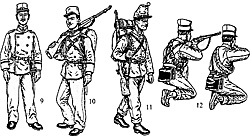 Large version of illustration: (slow download: 71K)
Large version of illustration: (slow download: 71K)
Figure 9: Infantry Corporal [?] , Undress Uniform, c.1907 [from photo] The shako has been replaced by a dark blue undress kepi [here of a somewhat older form, resembling late 19th century models] trimmed with a red piping circling the top of the dark blue band with a brass unit number on the front. The dark blue uniform piped with red is as depicted in earlier figures; the white neck scarf has been left off and his white shirt collar snows above the tunic collar.
The rather wide dark coloured [presumably red?] braids circling the sleeve just above the cuff piping begin to appear in photographs at about this period and are presumably rank insignia [based on their similarity to the rank distinctions given in the 1913-14 dress regulations] I suspect this new system of rank insignia for N.C.O.'s and men were introduced in the 1905 Dress Regulations, but am unable to absolutely confirm this.
Figure 10: Infantrymen, Warm Weather Campaign Dress, c.1907 [composite of 2 photos] The kepi is worn with a white cotton cover [the cylindrical flat-topped shape probably indicates a kepi of "Saumur" form] . Dark blue tunic trimmed with red piping edging the collar, shoulder straps, front opening and cuffs, brass buttons.
White neck scarf and white cotton trousers, black belts. The narrow waistbelt with "S" hook also begins to appear in photos about this time; presumably this was part of the range of accessories introduced to go with the new Mauser magazine rifle.
Figure 11: Infantryman, Tropical Campaign Dress, c.l.911 [from a previously unpublished sketch by J. Hefter] The shako is worn with a white cover, leaving the red pompon visible. Entirely plain white cotton single breasted tunic and trousers, brass buttons being the only trim. The black waistbelt is the older buckled form, though narrower than late 19th century models, as is also the case with the black pouchbelt over the left shoulder. The two rolls strapped to the pack are depicted as a darkish grey.
Figure 12: Infantrymen, Tropical Campaign Dress, c.1911 [from a photo by Agustin Casaola, the scion of the famous family of Mexican photographers] Both figures wear dark blue kepi's of "Saumur" form, circled by a red piping, white cotton tropical uniforms and sandals or "Huaraches". The figure on the left is one of two in the photo with dark [presumably red?] rank stripes circling the lower sleeve [about half-way between the wrist and elbow] , in addition he carries a brown leather bandolier of additional ammunition over the left shoulder and has additional cartridge pouches attached to the front of a dark [black or dark brown?] waistbelt. The figure on the right has an ammunition bandolier of white canvas and the legs of the typical white cotton under-drawers show below his rolled trouser legs.
The source photo purports to show a fire-fight between Federal Army troops and rebels of Emiliano Zapata's Southern forces, though it is somewhat less than convincing as such [particularly the wounded "Zapatista" lying comfortably on his side in the background, supporting his head with his left arm, as he calmly watches the bullets flying around him] . None the less, it is quite an interesting photo and shows typical campaign dress of the early war period. Of nine 'Federales" forming a firing line in the foreground of the photo, all but one wear the uniform depicted here, with the skirts of the tropical tunic tucked into the trousers [one figure has a rather darkish upper garment, possibly an early use of khaki?].
The photo shows clearly the cartridge carriers adopted for the Mauser rifle, resembling a large cartridge pouch with a soft black leather flap, slung over the left shoulder by a narrow strap. One man is getting a new clip from his cartridge carrier and has the flap raised, showing the interior [though not clearly]; It appears to have three large pockets for cartridge clips sewn in a horizontal row to the inner face of the carrier, with an internal "let-down" flap, carrying an additional three pockets attached at the bottom. In addition, most of the men have at least one, in some cases two, bandoliers of ammunition over the shoulders, of either leather or canvas.
The "odd man out" kneels at the far left of the photo and might be an officer, though he carries a rifle like the others. This figure wears a white [covered?] peaked service cap of "German" form, a loose white tunic with the skirts worn loose over white trousers unrolled at the bottom, boots or shoes instead of sandals and no visible belts, pouches or insignia. The "Zapatistas" in the background of the photo wear typical southern Mexican peasant clothing; white shirts or smocks, white trousers and broad-brimmed straw "sombreros".
The Federalist Army 1911-1913
The Constitutional Army 1913-1917
-
Figures 13-16: Gen., Pancho Villa, Capt., Major
Figures 17-20: Officers
Figures 21-23: Infantry
Figures 24-26: Infantry
Back to Table of Contents: Booklet No. 5, Mexican Army 1900-20
Back to El Dorado List of Issues
Back to Master Magazine List
© Copyright 1997 by The South and Central Military Historians Society
This article appears in MagWeb (Magazine Web) on the Internet World Wide Web.
Other military history articles and gaming articles are available at http://www.magweb.com